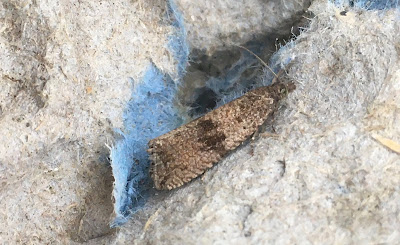 |
Rain has stopped play for the time being but I have a bit of a backlog, so I am not complaining. Before anything else, however, I must offer you a link to this wonderful episode. As the author says in his first paragraph, the headline 'Puffin in the Moth Trap' says it all. Warmest thanks to Peter Alfrey who gave me the link on the Upper Thames Moths blog after I posted news there of the bat which I found in my own trap - see last post here.
 |
My first two photographs don't show anything unusual, but something about the two Scarce Footmen and their jusxtaposition with the Forest Bug made me laugh. It's wrong to antrhropomorphise animals but if I were to run a caption competition for the pictures, I think that I might attract some witty entries.
Elsewhere in the eggboxes, I found the micros Celypha striana and the Common Plume below, but I was foxed by the insect in the third photo - distinctive but nowhere to be found in the Micro Moth Bible. The reason for this was revealed by Martin Harvey when I asked for help from the UTM blog. It isn't a moth but the caddis fly Mystacides longicornis.
Penny meanwhile made another of her famous Indoor Moth Spottings by finding this little creature, below,almost comatose but not dead. I think that it is a Small Scallop but cannot be absolutely sure. Update: Many thanks to Dave Wilton on the Upper Thames Moths Blog who clocks it as an Early Thorn, somewhat comatose but not yet, as he says, a late Early Thorn.The same uncertainty surrounds the pugs which follow. Pugs drive me up the wall but I will hazard the suggestion that these are both Brindled. Update: Dave to the rescue again: the second one he identifies as a Maple Pug, new to me, though I've no doubt overlooked them in the past. The first is too worn for a certain verdict.
The butterflies are meanwhile stupendous, dozens of Meadow Browns, Gatekeepers, Ringlets and Small, Lareg and Green-veined Whites in the garden, joined by the handsome new generation of Commas, Red Admirals and Peacocks. Here are some examples and I am sure that there will be many more to come.
 |
| One, two, three and finally four. For both Red Admirals and Peacocks, sunbathing is the thing. |
Here's a senior member of the Red Admiral family to finish up with, maybe a second generation example which has led a busy early life but more likely, I think, a stayer from the year's first, earlier hatching.










3 comments:
Hi Martin,
Put the Pugs on the UTM blog, they cannot be Brindled, Brindled finished up in May.
I think the 'Small Scallop' is a Lilac Beauty.
Stay safe,
Edward.
I just saw UTM post, as D. Wilton says, the first photo is misleading, which is what led me to think L.Beauty.
Hi there! Thanks again and I'm glad Dave cracked it. He is an amazing guru! All warm wishes M
Post a Comment